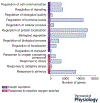The role of extracellular vesicles in skeletal muscle and systematic adaptation to exercise
- PMID: 31944292
- PMCID: PMC7363579
- DOI: 10.1113/JP278929
The role of extracellular vesicles in skeletal muscle and systematic adaptation to exercise
Abstract
Regular exercise has a central role in human health by reducing the risk of type 2 diabetes, obesity, stroke and cancer. How exercise is able to promote such systemic benefits has remained somewhat of a mystery but has been thought to be in part mediated by the release of myokines, skeletal muscle-specific cytokines, in response to exercise. Recent studies have revealed skeletal muscle can also release extracellular vesicles (EVs) into circulation following a bout of exercise. EVs are small membrane-bound vesicles capable of delivering biomolecules to recipient cells and subsequently altering their metabolism. The notion that EVs may have a role in both skeletal muscle and systemic adaptation to exercise has generated a great deal of excitement within a number of different fields including exercise physiology, neuroscience and metabolism. The purpose of this review is to provide an introduction to EV biology and what is currently known about skeletal muscle EVs and their potential role in the response of muscle and other tissues to exercise.
Keywords: exercise; extracellular vesicles; microRNAs; skeletal muscle.
© 2020 The Authors. The Journal of Physiology © 2020 The Physiological Society.
Conflict of interest statement
Competing interests
The authors declare no competing interests.
Figures




References
-
- Alvarez-Erviti L, Seow Y, Yin H, Betts C, Lakhal S & Wood MJ (2011). Delivery of siRNA to the mouse brain by systemic injection of targeted exosomes. Nat Biotechnol 29, 341–345 - PubMed
-
- Anderson HC, Garimella R & Tague SE (2005). The role of matrix vesicles in growth plate development and biomineralization. Front Biosci 10, 822–837. - PubMed
-
- Babst M, Katzmann DJ, Estepa-Sabal EJ, Meerloo T & Emr SD (2002a). Escrt-III: an endosome-associated heterooligomeric protein complex required for mvb sorting. Dev Cell 3, 271–282. - PubMed
-
- Babst M, Katzmann DJ, Snyder WB, Wendland B & Emr SD (2002b). Endosome-associated complex, ESCRT-II, recruits transport machinery for protein sorting at the multivesicular body. Dev Cell 3, 283–289. - PubMed
Publication types
MeSH terms
Grants and funding
LinkOut - more resources
Full Text Sources
Medical

